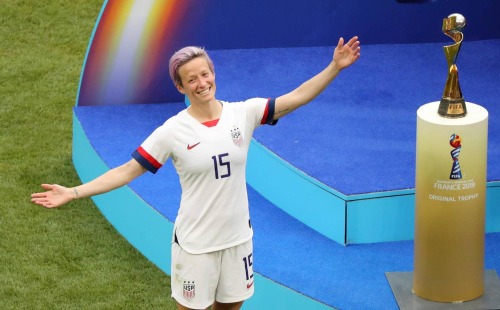25 Years In Space For ESA & NASA’s Sun-Watching SOHO
25 Years in Space for ESA & NASA’s Sun-Watching SOHO
A quarter-century ago, the Solar and Heliospheric Observatory (SOHO) launched to space. Its 25 years of data have changed the way we think about the Sun — illuminating everything from the Sun’s inner workings to the constant changes in its outermost atmosphere.

SOHO — a joint mission of the European Space Agency and NASA — carries 12 instruments to study different aspects of the Sun. One of the gamechangers was SOHO’s coronagraph, a type of instrument that uses a solid disk to block out the bright face of the Sun and reveal the relatively faint outer atmosphere, the corona. With SOHO’s coronagraph, scientists could image giant eruptions of solar material and magnetic fields, called coronal mass ejections, or CMEs. SOHO’s images revealed shape and structure of CMEs in breathtaking detail.

These solar storms can impact robotic spacecraft in their path, or — when intense and aimed at Earth — threaten astronauts on spacewalks and even disrupt power grids on the ground. SOHO is particularly useful in viewing Earth-bound storms, called halo CMEs — so called because when a CME barrels toward us on Earth, it appears circular, surrounding the Sun, much like watching a balloon inflate by looking down on it.

Before SOHO, the scientific community debated whether or not it was even possible to witness a CME coming straight toward us. Today, SOHO images are the backbone of space weather prediction models, regularly used in forecasting the impacts of space weather events traveling toward Earth.
Beyond the day-to-day monitoring of space weather, SOHO has been able to provide insight about our dynamic Sun on longer timescales as well. With 25 years under its belt, SOHO has observed a full magnetic cycle — when the Sun’s magnetic poles switch places and then flip back again, a process that takes about 22 years in total. This trove of data has led to revolutions in solar science: from revelations about the behavior of the solar core to new insight into space weather events that explode from the Sun and travel throughout the solar system.
Data from SOHO, sonified by the Stanford Experimental Physics Lab, captures the Sun’s natural vibrations and provides scientists with a concrete representation of its dynamic movements.
The legacy of SOHO’s instruments — such as the extreme ultraviolet imager, the first of its kind to fly in orbit — also paved the way for the next generation of NASA solar satellites, like the Solar Dynamics Observatory and STEREO. Even with these newer instruments now in orbit, SOHO’s data remains an invaluable part of solar science, producing nearly 200 scientific papers every year.

Relatively early in its mission, SOHO had a brush with catastrophe. During a routine calibration procedure in June 1998, the operations team lost contact with the spacecraft. With the help of a radio telescope in Arecibo, the team eventually located SOHO and brought it back online by November of that year. But luck only held out so long: Complications from the near loss emerged just weeks later, when all three gyroscopes — which help the spacecraft point in the right direction — failed. The spacecraft was no longer stabilized. Undaunted, the team’s software engineers developed a new program that would stabilize the spacecraft without the gyroscopes. SOHO resumed normal operations in February 1999, becoming the first spacecraft of its kind to function without gyroscopes.

SOHO’s coronagraph have also helped the Sun-studying mission become the greatest comet finder of all time. The mission’s data has revealed more than 4,000 comets to date, many of which were found by citizen scientists. SOHO’s online data during the early days of the mission made it possible for anyone to carefully scrutinize a image and potentially spot a comet heading toward the Sun. Amateur astronomers from across the globe joined the hunt and began sending their findings to the SOHO team. To ease the burden on their inboxes, the team created the SOHO Sungrazer Project, where citizen scientists could share their findings.

Keep up with the latest SOHO findings at nasa.gov/soho, and follow along with @NASASun on Twitter and facebook.com/NASASunScience.
Make sure to follow us on Tumblr for your regular dose of space: http://nasa.tumblr.com.
More Posts from Thehkr and Others
The ranks of America’s Astronaut Corps grew by 11 today!
After completing more than two years of basic training, our graduating class of astronauts is eligible for spaceflight. Assignments include the International Space Station, Artemis missions to the Moon, and ultimately, missions to Mars.
The class includes 11 astronauts, selected in 2017 from a record-setting pool of more than 18,000 applicants. This was more than double the previous record of 8,000 applicants set in 1978.
Meet the graduates:
Kayla Barron

“If you don’t love what you’re doing, you’re not going to be good at it. I think it’s a combination of finding things that you really love that will also be really challenging and will force you to grow along the way.”
This Washington native graduated from the U.S. Naval Academy with a bachelor’s degree in systems engineering. As a Gates Cambridge Scholar, which offers students an opportunity to pursue graduate study in the field of their choice at the University of Cambridge. Barron earned a master’s degree in nuclear engineering.
As a Submarine Warfare Officer, Barron was part of the first class of women commissioned into the submarine community, completing three strategic deterrent patrols aboard the USS Maine.
Zena Cardman

“Every STEM opportunity that I have ever gone down is because of some mentor who inspired me or some student who was ahead of me in school who inspired me.”
Zena Cardman is a native of Virginia and completed a bachelor’s degree in biology and master’s degree in marine sciences at The University of North Carolina, Chapel Hill. Her research has focused on microorganisms in subsurface environments, ranging from caves to deep sea sediments.
An intrepid explorer, Cardman’s field experience includes multiple Antarctic expeditions, work aboard research vessels as both scientist and crew, and NASA analog missions in British Columbia, Idaho, and Hawaii.
Raja Chari

“I grew up with the mentality that education is truly a gift not to be taken for granted.”
This Iowa native graduated from the U.S. Air Force Academy in 1999 with bachelor’s degrees in astronautical engineering and engineering science. He continued on to earn a master’s degree in aeronautics and astronautics from Massachusetts Institute of Technology (MIT) and graduated from the U.S. Naval Test Pilot School.
Chari served as the Commander of the 461st Flight Test Squadron and the Director of the F-35 Integrated Test Force. He has accumulated more than 2,000 hours of flight time in the F-35, F-15, F-16 and F-18 including F-15E combat missions in Operation Iraqi Freedom.
Matthew Dominick

“I get to work with incredible people that want to solve problems and are passionate about it. I really want to contribute to the world and this is how I want to do it.”
This Colorado native earned a bachelor’s degree in electrical engineering from the University of San Diego and a master’s degree in systems engineering from the Naval Postgraduate School. He also graduated from U.S. Naval Test Pilot School.
Dominick served on the USS Ronald Reagan as department head for Strike Fighter Squadron 115. He has more than 1,600 hours of flight time in 28 aircraft, 400 carrier-arrested landings and 61 combat missions.
Bob Hines

“As you get older, other things become important to you, like being a part of something that’s bigger than yourself. This human endeavor of exploration is something that’s really exciting.”
Bob Hines is a Pennsylvania native and earned a bachelor’s degree in aerospace engineering from Boston University. He is a graduate of the U.S. Air Force Test Pilot School, where he earned a master’s degree in flight test engineering. He continued on to earn a master’s degree in aerospace engineering from the University of Alabama.
Hines served in the U.S. Air Force and Air Force Reserves for 18 years. He also served as a research pilot at our Johnson Space Center. He has accumulated more than 3,500 hours of flight time in 41 different types of aircraft and has flown 76 combat missions in support of contingency operations around the world.
Warren Hoburg

“It was back in high school that I realized that I was really interested in engineering. I always liked taking things apart and understanding how things work and then I also really enjoy solving problems.”
Nicknamed “Woody”, this Pennsylvania native earned a bachelor’s degree in aeronautics and astronautics from MIT and a doctorate in electrical engineering and computer science from the University of California, Berkeley.
Hoburg was leading a research group at MIT at the time of his selection and is a two-time recipient of the AIAA Aeronautics and Astronautics Teaching Award in recognition of outstanding teaching.
Dr. Jonny Kim

“I fundamentally believed in the NASA mission of advancing our space frontier, all while developing innovation and new technologies that would benefit all of humankind.”
This California native trained and operated as a Navy SEAL, completing more than 100 combat operations and earning a Silver Star and Bronze Star with Combat “V”. Afterward, he went on to complete a degree in mathematics at the University of San Diego and a doctorate of medicine at Harvard Medical School.
Kim was a resident physician in emergency medicine with Partners Healthcare at Massachusetts General Hospital.
Jasmin Moghbeli

“Surround yourself with good people that have the characteristics that you want to grow in yourself. I think if you surround yourself with people like that you kind of bring each other up to a higher and higher level as you go.”
Jasmin Moghbeli, a U.S. Marine Corps major, considers Baldwin, New York, her hometown. She earned a bachelor’s degree in aerospace engineering with information technology at MIT, followed by a master’s degree in aerospace engineering from the Naval Postgraduate School.
She is a distinguished graduate of the U.S. Naval Test Pilot School and has accumulated more than 1,600 hours of flight time and 150 combat missions.
Loral O’Hara

“I’m one of those people who have wanted to be an astronaut since I was a little kid, and I think that came from an early obsession with flying – birds, airplanes, rockets.”
This Houston native earned a bachelor’s degree in aerospace engineering at the University of Kansas and a Master of Science degree in aeronautics and astronautics from Purdue University. As a student, she participated in multiple NASA internship programs, including the Reduced Gravity Student Flight Opportunities Program, the NASA Academy at Goddard Space Flight Center, and the internship program at the Jet Propulsion Laboratory.
O’Hara was a research engineer at Woods Hole Oceanographic Institution, where she worked on the engineering, test and operations of deep-ocean research submersibles and robots. She is also a private pilot and certified EMT and wilderness first responder.
Dr. Frank Rubio

“I just figured it was time to take the plunge and try it. And so, I did and beyond all dreams, it came true.”
Dr. Francisco “Frank” Rubio, a U.S. Army lieutenant colonel, is originally from Miami. He earned a bachelor’s degree in international relations from the U.S. Military Academy and earned a doctorate of medicine from the Uniformed Services University of the Health Sciences.
Rubio served as a UH-60 Blackhawk helicopter pilot and flew more than 1,100 hours, including more than 600 hours of combat and imminent danger time during deployments to Bosnia, Afghanistan, and Iraq. He is also a board certified family physician and flight surgeon.
Jessica Watkins

“I’ve always been interested in exploring space. What’s out there and how can we as humans reach those outer stars and how can we learn more information about who we are through that process.”
This Colorado native earned a bachelor’s degree in geological and environmental sciences at Stanford University, and a doctorate in geology from the University of California, Los Angeles. Watkins has worked at Ames Research Center and the Jet Propulsion Laboratory.
Watkins was a postdoctoral fellow at the California Institute of Technology, where she collaborated on the Mars Curiosity rover, participating in daily planning of rover activities and investigating the geologic history of the Red Planet.
Learn more about the new space heroes right here: https://www.nasa.gov/newastronauts
Make sure to follow us on Tumblr for your regular dose of space: http://nasa.tumblr.com.

The Space Shuttle Challenger landed #OTD in 1983.
Here are astronauts Richard Truly & Guion Bluford of Space Transport System 8 (STS-8) grabbing some shut-eye before the wrap up of their mission. This mission had:
The first African American, Guion Bluford, to fly in space
The first night launch and landing during the Space Shuttle Program
Make sure to follow us on Tumblr for your regular dose of space: http://nasa.tumblr.com


Angie Varona




Hadas Cohen




Build a Rover, Race a Rover!

Have you ever wanted to drive a rover across the surface of the Moon?
This weekend, students from around the world will get their chance to live out the experience on Earth! At the Human Exploration Rover Challenge, managed by NASA’s Marshall Space Flight Center in Huntsville, Alabama, high schoolers and college students operate human-powered rovers that they designed and built as they traverse a simulated world, making decisions and facing obstacles that replicate what the next generation of explorers will face in space.

Though the teams that build the rover can be a few people or a few dozen, in the end, two students (one male, one female) will end up navigating their rover through a custom-built course at the U.S. Space and Rocket Center. Each duo will push their rover to the limit, climbing up hills, bumping over rocky and gravelly grounds, and completing mission objectives (like retrieving soil samples and planting their team flag) for extra points – all in less than seven minutes.

2019 will mark the 25th year of Rover Challenge, which started life as the Great Moonbuggy Race on July 16, 1994. Six teams braved the rain and terrain (without a time limit) in the Rocket City that first year – and in the end, the University of New Hampshire emerged victorious, powering through the moon craters, boulder fields and other obstacles in eighteen minutes and fifty-five seconds.

When it came time to present that year’s design awards, though, the honors went to the University of Puerto Rico at Humacao, who have since become the only school to compete in every Great Moonbuggy Race and Rover Challenge hosted by NASA Marshall. The second-place finishers in 1994, the hometown University of Alabama in Huntsville, are the only other school to compete in both the first race and the 25th anniversary race in 2019.

Since that first expedition, the competition has only grown: the race was officially renamed the Human Exploration Rover Challenge for 2014, requiring teams to build even more of their rover from the wheels up, and last year, new challenges and tasks were added to better reflect the experience of completing a NASA mission on another planet. This year, almost 100 teams will be competing in Rover Challenge, hailing from 24 states, Washington, D.C., Puerto Rico, and countries from Bolivia to Bangladesh.

Rover Challenge honors the legacy of the NASA Lunar Roving Vehicle, which made its first excursion on the moon in 1971, driven by astronauts David Scott and James Irwin on Apollo 15. Given the competition’s space race inspiration, it’s only appropriate that the 25th year of Rover Challenge is happening in 2019, the 50th anniversary of Neil Armstrong and Buzz Aldrin’s historic Apollo 11 moon landing.

Interested in learning more about Rover Challenge? Get the details on the NASA Rover Challenge site – then join us at the U.S. Space and Rocket Center (entrance is free) or watch live on the Rover Challenge Facebook Page starting at 7 AM CT, this Friday, April 12 and Saturday, April 13. Happy roving!
Make sure to follow us on Tumblr for your regular dose of space: http://nasa.tumblr.com
Every next level of your life will demand a different you.
Leonardo DiCaprio (via quotemadness)
-
 flowerzbloozworld liked this · 1 year ago
flowerzbloozworld liked this · 1 year ago -
 images-of-all-kinds reblogged this · 1 year ago
images-of-all-kinds reblogged this · 1 year ago -
 crookedbouquetchopshop liked this · 1 year ago
crookedbouquetchopshop liked this · 1 year ago -
 cat-wo-mando liked this · 1 year ago
cat-wo-mando liked this · 1 year ago -
 cheesssecake reblogged this · 2 years ago
cheesssecake reblogged this · 2 years ago -
 cheesssecake liked this · 2 years ago
cheesssecake liked this · 2 years ago -
 sillypsycho124 liked this · 2 years ago
sillypsycho124 liked this · 2 years ago -
 kassyariana liked this · 2 years ago
kassyariana liked this · 2 years ago -
 eosforge liked this · 2 years ago
eosforge liked this · 2 years ago -
 sleepy-alien002 liked this · 2 years ago
sleepy-alien002 liked this · 2 years ago -
 carocelyn liked this · 2 years ago
carocelyn liked this · 2 years ago -
 dotchkhaked liked this · 2 years ago
dotchkhaked liked this · 2 years ago -
 nameschrisco liked this · 2 years ago
nameschrisco liked this · 2 years ago -
 istillbelieveinmagic142 liked this · 2 years ago
istillbelieveinmagic142 liked this · 2 years ago -
 notyourtoday liked this · 2 years ago
notyourtoday liked this · 2 years ago -
 klss liked this · 2 years ago
klss liked this · 2 years ago -
 v0n-dutch liked this · 2 years ago
v0n-dutch liked this · 2 years ago -
 beverly-hoot85676-blog liked this · 3 years ago
beverly-hoot85676-blog liked this · 3 years ago -
 bazdmegklute liked this · 3 years ago
bazdmegklute liked this · 3 years ago -
 rustyicepick liked this · 3 years ago
rustyicepick liked this · 3 years ago